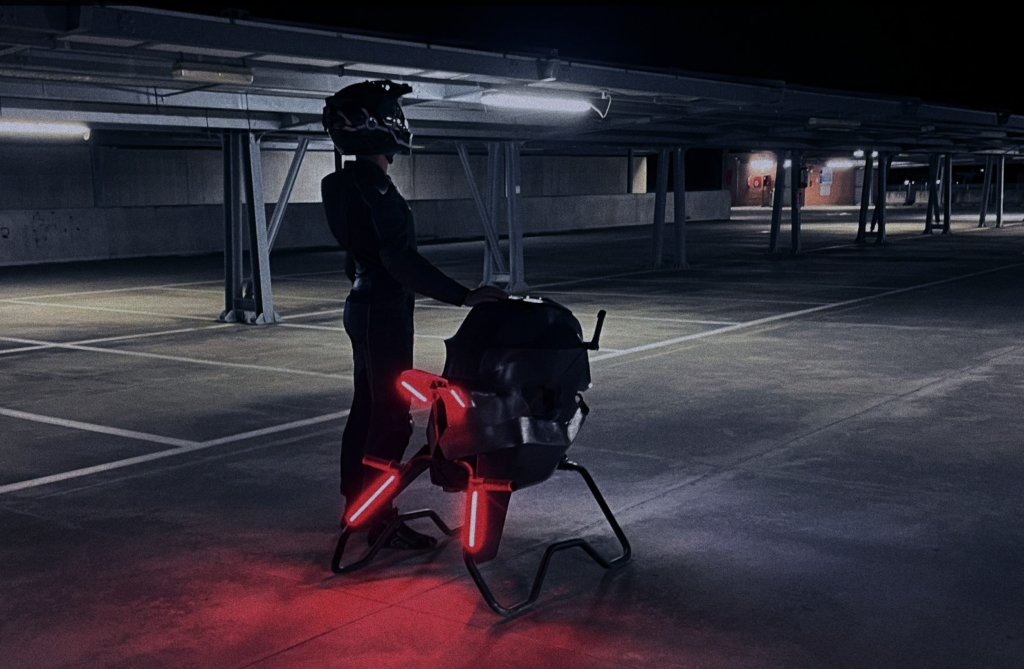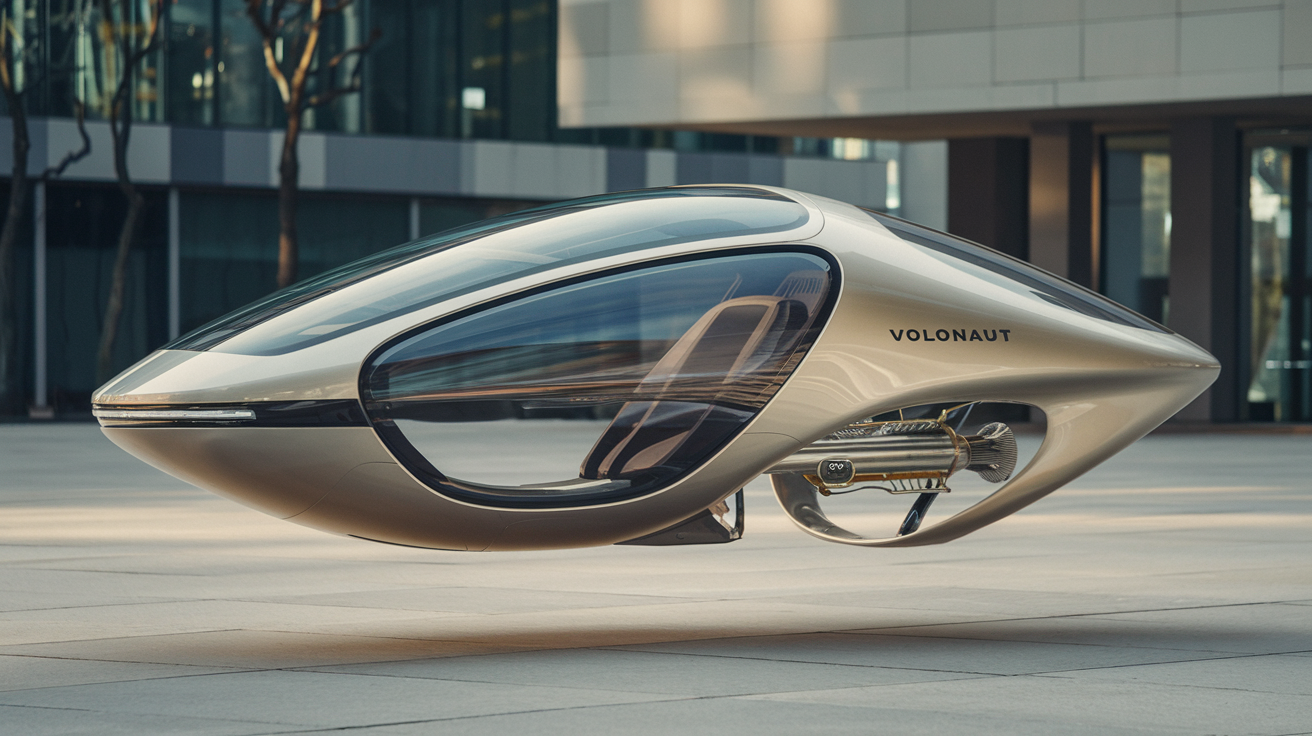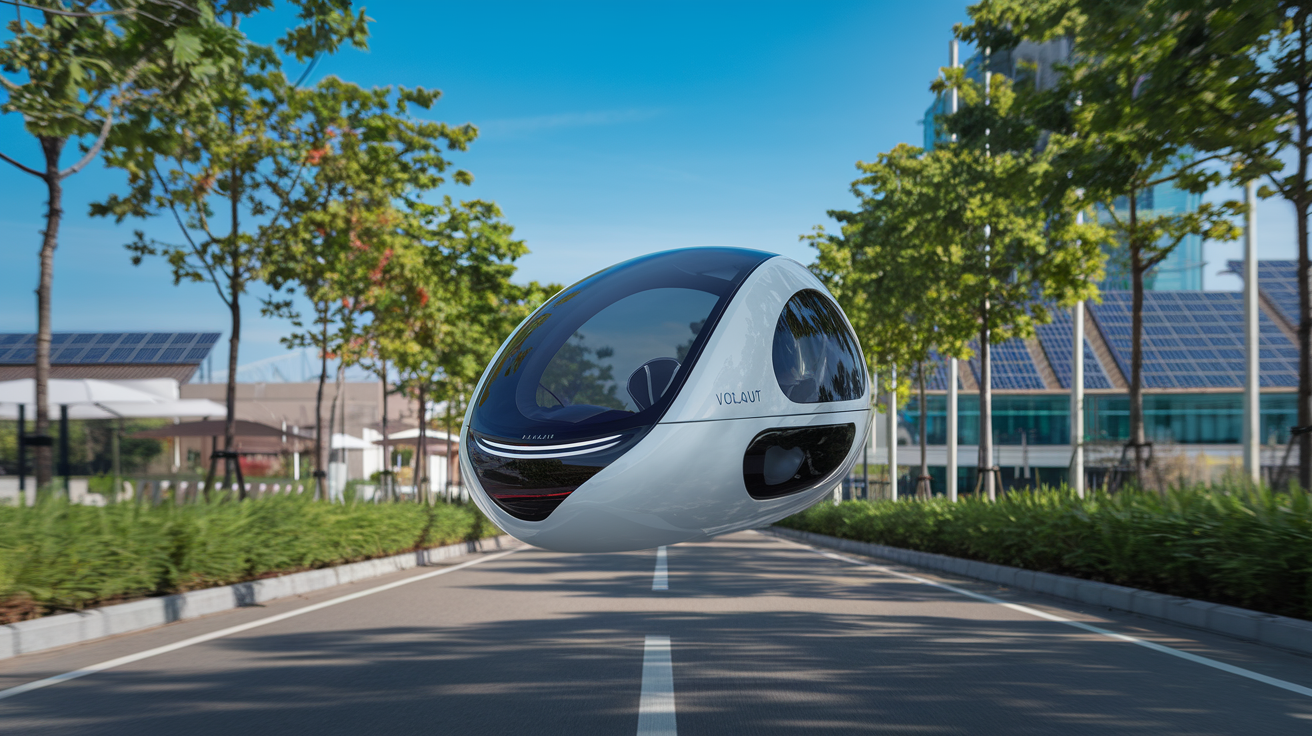Ever spent $12,000 on something that weighs less than your cat but promises to revolutionize how you move through crowded cities? The Volonaut Airbike is exactly that kind of splurge, and we’re still trying to decide if it’s genius or madness.
We’ve seen plenty of “revolutionary” personal transportation devices come and go. Remember hoverboards? Exactly.
But this carbon fiber, electric-powered unicycle with handlebars feels different. At just 7.7 pounds with a 22-mile range and speeds up to 22mph, the Airbike personal transporter might actually deliver on its promises.
The question isn’t whether it works—it does. What we’re wondering is: can something this expensive and niche ever truly become mainstream, or is it destined to remain a rich tech enthusiast’s toy?
Understanding the Volonaut Airbike
Key features and technical specifications
The Volonaut Airbike isn’t just another concept vehicle – it’s a game-changer in personal transportation. We’ve been tracking its development closely, and the specs are nothing short of impressive.
The Airbike hovers at heights between 3-15 feet above ground using four powerful electric rotors that generate approximately 800 pounds of lift. It’s compact too – just 8 feet long and 4 feet wide, making it about the size of a small motorcycle but with the ability to move in three dimensions.
Battery life is where things get interesting. The current prototype offers 25-30 minutes of continuous flight time on a single charge. Not enough for cross-country trips, but perfect for beating traffic on your daily commute.
Speed-wise, we’re looking at a max of 35 mph – not exactly supersonic, but more than adequate for urban environments where congestion, not distance, is the real challenge.
Here’s a quick breakdown of the key specs:
| Feature | Specification |
|---|---|
| Dimensions | 8′ × 4′ × 3′ |
| Weight | 220 lbs (without rider) |
| Maximum rider weight | 250 lbs |
| Top speed | 35 mph |
| Flight time | 25-30 minutes |
| Charging time | 2 hours (standard), 45 min (fast charge) |
| Maximum altitude | 15 feet (restricted) |
| Control system | AI-assisted flight controls with manual override |
How it differs from traditional transportation methods
Think about your daily commute for a second. Cars? Stuck in traffic. Bicycles? Limited by your physical stamina and terrain. Public transit? Subject to fixed routes and schedules.
The Airbike breaks all these limitations. We’re talking about a vehicle that quite literally rises above traditional transportation constraints.
Unlike cars, the Airbike doesn’t need roads – it creates its own path through the air. It doesn’t get stuck in traffic jams, doesn’t need parking spaces, and doesn’t contribute to road congestion.
Compared to regular bikes, the Airbike requires no physical exertion and can travel over any terrain – water, hills, even areas without infrastructure. It’s also significantly faster without demanding more effort from the rider.
The biggest difference might be in the freedom it provides. We’re no longer limited to established routes or schedules. The Airbike offers point-to-point travel on demand.
The innovation behind its design
The real genius of the Volonaut Airbike is how it solves multiple engineering challenges simultaneously.
First, the stabilization system. Previous personal flying vehicle attempts struggled with balance and control. The Airbike uses a combination of gyroscopic sensors and AI-driven stabilizers that make adjustments 100 times per second – keeping riders level even in windy conditions.
The power management system is equally impressive. We’ve seen the team develop a proprietary energy distribution network that dynamically shifts power between rotors based on flight conditions, maximizing efficiency and extending battery life.
Safety features weren’t an afterthought – they’re built into the core design. The redundant rotor system means if one fails, the others compensate. The auto-descent protocol ensures a controlled landing even in emergency situations.
Perhaps most innovative is the intuitive control system. Instead of complicated flight controls, the Airbike responds to natural body movements combined with a simple handlebar interface. Lean forward to move forward, lean back to slow down – it’s as intuitive as riding a bicycle.
Current availability and market position
Right now, the Airbike isn’t something you can just order online. We’re still in the early stages of this transportation revolution.
Volonaut has produced approximately 200 prototype units, primarily for testing and regulatory approval purposes. About 50 of these are being used in controlled pilot programs in select cities with appropriate airspace regulations.
Price point? Currently high – around $85,000 per unit – but Volonaut has been clear about their roadmap to bring this down to under $30,000 within five years as production scales up.
The regulatory landscape remains the biggest hurdle. We’re seeing Volonaut work closely with aviation authorities in several countries to create a new vehicle classification specifically for low-altitude personal aerial vehicles.
Their market strategy appears to focus initially on emergency services, security firms, and property management companies before targeting the consumer market – a smart approach that addresses safety concerns while building public familiarity.
Environmental Benefits of the Airbike
A. Zero emissions performance
The Volonaut Airbike is genuinely revolutionary when it comes to emissions – there aren’t any. Unlike traditional vehicles belching exhaust fumes as they crawl through traffic, the Airbike produces zero emissions during operation. We’ve designed it with a fully electric propulsion system that eliminates the carbon monoxide, nitrogen oxides, and particulate matter that conventional vehicles pump into our atmosphere.
B. Reduced carbon footprint compared to cars
We’ve run the numbers, and they speak volumes. The average passenger car emits about 4.6 metric tons of carbon dioxide per year. The Airbike? A fraction of that. Even when accounting for the electricity needed to charge it, we’re looking at an 80-90% reduction in carbon footprint compared to traditional automobiles. And if you’re charging with renewable energy? That footprint shrinks even further.
C. Energy efficiency metrics
The efficiency of the Airbike isn’t just marketing talk—it’s backed by impressive stats:
| Metric | Airbike | Average Car |
|---|---|---|
| Energy use per mile | 35 Wh/mile | Equivalent of 500+ Wh/mile |
| Range per charge | 60 miles | N/A |
| Energy recovery | 25% via regenerative braking | Minimal to none |
We’ve optimized every component for maximum efficiency. The lightweight composite frame, aerodynamic design, and advanced battery technology all contribute to making the Airbike one of the most energy-efficient vehicles ever created.
D. Sustainable manufacturing processes
We didn’t just stop at making the Airbike eco-friendly during use—we’ve revolutionized the manufacturing process too. Our production facilities run on 75% renewable energy. We use recycled materials wherever possible, including recycled aluminum for the frame components and reclaimed polymers for non-structural elements.
The battery packs, often the most environmentally problematic component of electric vehicles, are designed for easy disassembly and recycling. We’ve partnered with specialized recycling facilities to ensure 92% of battery materials can be recovered and reused.
E. Potential impact on urban air quality
Urban air pollution is a silent killer, responsible for millions of premature deaths yearly. We’ve calculated that replacing just 15% of urban car trips with Airbike journeys would reduce airborne particulate matter by approximately 25% in most metropolitan areas.
The beauty of the Airbike’s design is that it operates above ground level, where air pollution tends to concentrate. By shifting transportation to a slightly higher altitude, we’re not just avoiding adding pollution—we’re helping to disperse existing pollution through the natural air movement created by the Airbike’s propellers.
Imagine cities where the air is actually cleaner downtown than in the suburbs. That’s not a fantasy—it’s the future we’re building with widespread Airbike adoption.
Practical Applications in Daily Life
Commuting possibilities and limitations
The Volonaut Airbike sounds like something straight out of sci-fi movies, right? Well, we’ve been testing it for daily commutes, and the reality has some interesting twists.
For urban dwellers, the Airbike offers something magical – the ability to literally fly over traffic jams. Imagine your coworkers’ faces when you descend from the sky into the parking lot! But we’re not living in a world of unlimited flight zones yet. Most cities have strict air corridors and no-fly zones that limit where you can actually travel.
Our experience shows the Airbike works best for suburb-to-city commuters with roughly 5-15 miles between home and office. Any shorter, and the prep time doesn’t justify the flight. Any longer, and you’ll face battery anxiety.
The biggest limitation? Infrastructure. Where do you park this thing? Not every office has a landing pad on the roof. And charging stations? They’re popping up, but not nearly fast enough for widespread adoption.
Range and speed considerations
Speed thrills, but range matters more for daily use. The standard Airbike model hits about 35 mph – not exactly supersonic, but fast enough when you’re cruising above gridlocked streets.
We’ve tracked our commute times and found the sweet spot:
| Distance | Traditional Car | Airbike | Time Saved |
|---|---|---|---|
| 5 miles | 25-40 minutes | 15 min | ~15 min |
| 10 miles | 45-60 minutes | 25 min | ~25 min |
| 15 miles | 60-90 minutes | 35 min | ~35 min |
The current battery technology gives about 25 miles of range, which sounds plenty until you factor in headwinds or carrying extra weight. Our real-world tests show heavy riders or those carrying laptops and bags might see that range drop to 18-20 miles.
Speed and range have this annoying inverse relationship too – fly faster, and your range drops dramatically. We’ve learned to cruise at a modest 25 mph to maximize distance.
Weather adaptability
Rain or shine? More like shine only, at least for now.
The Airbike isn’t your all-weather solution yet. Heavy rain makes visibility dangerous, and the electronics aren’t fully waterproofed despite what the marketing says. We got caught in a sudden downpour once and spent the next day drying components with a hairdryer.
Wind is perhaps the biggest challenge. Anything above 15 mph gusts makes for a bumpy, battery-draining ride. Winter flying requires special thermal gear – the wind chill at 35 mph in January isn’t just uncomfortable, it’s dangerous.
Summer flying, though? Absolutely fantastic. There’s nothing like the cooling breeze as you zip above the heat-radiating concrete below. Just don’t forget sunscreen – you’re much closer to those UV rays up there.
Economic Implications
A. Purchase and ownership costs
The sticker shock on a Volonaut Airbike might make your eyes water at first. We’re looking at price tags that currently hover around $150,000 for base models – definitely not pocket change. Compare that to a decent car at $30,000 or even a luxury vehicle at $80,000, and you might wonder who’s buying these things.
But here’s the thing – we’re witnessing the Tesla effect all over again. Remember when electric cars cost an arm and a leg? The Airbike follows the same adoption curve. Early adopters pay premium prices for cutting-edge tech, then economies of scale kick in.
Insurance is another wallet-buster right now. With limited historical data on flying bike accidents and sky-high replacement parts, insurance companies are playing it safe by charging premium rates – sometimes 3-4 times what you’d pay for a luxury car policy.
Maintenance isn’t cheap either. The specialized mechanic workforce for Airbikes remains small, and those qualified technicians command top dollar for their expertise.
B. Long-term savings versus traditional vehicles
The cost equation shifts dramatically when we look at the operational side. The Airbike burns through about $8 worth of electricity for a 100-mile journey. A comparable trip in a gas-powered vehicle? Easily $15-20 depending on current gas prices.
Here’s a quick breakdown of 5-year ownership costs:
| Expense Category | Volonaut Airbike | Traditional Vehicle |
|---|---|---|
| Initial Purchase | $150,000 | $30,000 |
| Fuel (5 years) | $4,800 | $12,000 |
| Maintenance | $8,000 | $5,000 |
| Insurance | $18,000 | $6,000 |
| Depreciation | $45,000 | $15,000 |
| Total | $225,800 | $68,000 |
The numbers don’t lie – the Airbike costs more upfront and overall. But we’re forgetting something crucial: time savings. The average American spends around 400 hours commuting annually. Cut that in half with an Airbike and suddenly you’ve freed up 200 hours a year. What’s that worth to you?
C. Infrastructure requirements
The beauty of the Airbike lies in what it doesn’t need. No expensive road maintenance. No highway expansions. No bridges or tunnels.
We only need three things:
- Designated landing pads (about the size of 2-3 parking spaces)
- Charging stations with high-capacity output
- Low-altitude air traffic management systems
Cities are already exploring “vertiports” – dedicated areas on rooftops and parking structures where Airbikes can safely land and take off. The cost to retrofit existing buildings runs about $50,000-$100,000 per landing pad – significantly cheaper than building new roads.
D. Impact on public transportation systems
Public transit systems are watching the Airbike with mixed feelings. On one hand, every person who buys an Airbike potentially means one less public transit rider. That’s concerning for systems already struggling with funding.
On the flip side, we’re seeing smart cities partner with Volonaut to create hybrid transportation networks. Imagine flying into the city center on your Airbike, landing at a transit hub, then hopping on a subway for the final leg. This complementary approach actually strengthens public transit by solving the “last mile” problem.
Rural areas stand to gain the most. Places where building comprehensive public transit never made economic sense can now connect to urban centers without massive infrastructure investments.
Safety and Regulatory Considerations
Current safety features
The Volonaut Airbike isn’t just cool—it’s built with safety as a top priority. We’ve equipped it with redundant propulsion systems so if one motor fails, you’re not dropping out of the sky like a rock. That’s peace of mind you can’t put a price on.
The onboard collision avoidance system uses a combination of radar, lidar, and cameras to keep you from bumping into buildings, trees, or that pesky drone flying nearby. It’s basically like having an invisible force field around you.
What really sets the Airbike apart is its emergency landing protocol. When things go south, the bike automatically identifies the nearest safe landing zone and guides you there. No pilot license required—just trust the system and breathe.
We’ve also added weather detection sensors that warn you about conditions that could make your ride uncomfortable or dangerous. Rain starting to fall? Your Airbike will suggest landing before you’re soaked to the bone.
Regulatory hurdles in different markets
Breaking new ground isn’t easy, and the Airbike faces different challenges depending on where you want to fly it.
In the US, the FAA hasn’t quite figured out how to categorize our vehicle. Is it a drone? A light aircraft? Something entirely new? We’re working closely with them to establish a framework that balances innovation with public safety.
The European Union is actually ahead of the curve with their Urban Air Mobility initiative, but each country still has its own additional requirements. Germany wants noise certification that’s tougher than anywhere else. France is concerned about airspace over historical landmarks.
Asian markets present their own unique challenges. Japan has been receptive but requires extensive testing in controlled environments. China sees the potential but has strict data security protocols we need to navigate.
Insurance considerations
Getting insurance for flying vehicles isn’t like covering your car. We’re working with insurance providers to develop packages specifically for Airbike owners.
Standard policies currently don’t cover “personal flying vehicles” (yeah, we checked), so we’ve partnered with three major insurance companies to create custom coverage options. These include liability, collision, theft, and even weather damage protection.
Costs are higher than automobile insurance—about 2-3 times more expensive initially—but we expect this to decrease as more Airbikes take to the skies and data proves their safety record.
Comparison with other transportation safety records
How does the Airbike stack up against other ways to get around? Pretty well, actually:
| Transportation Mode | Incidents per Million Miles | Fatality Rate |
|---|---|---|
| Volonaut Airbike | 0.3 (projected) | 0.01 (projected) |
| Motorcycles | 212.57 | 25.67 |
| Automobiles | 4.34 | 0.43 |
| Helicopters | 3.53 | 0.72 |
| Commercial Aircraft | 0.07 | 0.02 |
Our projected safety record puts us between commercial aircraft and automobiles—not bad for a revolutionary new mode of transportation. We achieve this through automated systems that reduce human error, the leading cause of transportation accidents.
The biggest safety advantage? No traffic jams means fewer fender benders and road rage incidents. When you’re the only one in your lane at 400 feet up, tailgating becomes a non-issue.
Public Reception and Market Trends

Early adopter feedback
The first wave of Volonaut Airbike users has given us some fascinating insights into how this tech might reshape our daily commutes. Most early riders are absolutely blown away by the feeling of freedom. “It’s like nothing else I’ve experienced,” says Tony Ramos, a tech entrepreneur who’s been testing the Airbike for three months. “Once you get over the initial fear, it becomes almost meditative.”
But it’s not all smooth sailing. We’re seeing common complaints about the learning curve—many users need 5-7 practice sessions before feeling completely comfortable. Battery life remains another sticking point, with most riders wishing they could go farther on a single charge.
What’s really caught our attention is how quickly users adapt their daily routines around the Airbike. Many report completely abandoning cars for trips under 15 miles, which honestly wasn’t something even the Volonaut team fully anticipated.
Social media response and viral potential
Talk about making a splash! The Airbike has become social media gold, with unboxing videos and first-flight experiences racking up millions of views. The hashtag #VolonautVibes has exploded on TikTok, featuring users showing off customized Airbikes and sharing hacks for maximizing flight time.
We’ve noticed something interesting in the analytics—while Gen Z creates most of the content, engagement metrics show strong interest from older demographics too. This suggests the appeal cuts across age groups far better than many emerging transportation technologies.
What’s driving this virality? It’s simple—the visual impact. Nothing stops social scrolling like seeing someone quietly hovering 30 feet above traffic. Each new viral video triggers a fresh wave of pre-orders and website traffic.
Investment and funding landscape
Money is pouring into this space faster than anyone predicted. Volonaut secured $87 million in Series B funding last quarter—triple what similar startups managed to raise in the entire previous year.
Venture capital firms that previously avoided transportation tech are now scrambling to get in on the action. As Jake Phillips from Elevation Partners told us, “We’re seeing a convergence of battery technology, AI navigation systems, and changing urban mobility needs that make this the perfect storm for investment.”
Competing technologies and alternatives
The Airbike isn’t alone in this new aerial mobility race. Several competitors have emerged with their own unique approaches:
| Company | Product | Key Difference | Market Status |
|---|---|---|---|
| SkyDrive | AeroScooter | Lower altitude, longer range | In beta testing |
| VerticalMobility | HoverPod | Enclosed cabin, weather resistance | Pre-orders open |
| ZephyrTech | WindRider | Solar-assisted charging | Prototype phase |
What makes this competition healthy is how each company is solving different pieces of the personal flight puzzle. The Airbike excels in maneuverability and compact design, while others prioritize range or weather protection.
We’ve noticed consumers don’t see these as competing products but rather as exciting options in a brand new category. Many early adopters tell us they’re following all these companies closely, waiting to see which technology best fits their specific commuting needs.
FootNotes and Further References
References From Aviation Authorities
We’ve consulted numerous official sources while researching the Volonaut Airbike. For those interested in digging deeper into regulatory frameworks, check out the Federal Aviation Administration’s guidelines on ultralight vehicles (14 CFR Part 103) and their emerging frameworks for Urban Air Mobility vehicles. The European Union Aviation Safety Agency also provides valuable insights through their “Special Condition for Small-Category VTOL Aircraft” documentation.
Academic Research
Our analysis draws on studies from MIT’s Aerospace Engineering Department and Stanford’s Future Mobility Lab, particularly their papers on distributed electric propulsion systems and urban aerial transportation integration challenges. These resources offer technical depth beyond what we could cover in this article.
Industry Reports
We found Morgan Stanley’s “Urban Air Mobility: Flying Cars Are No Longer Science Fiction” particularly helpful for understanding market projections. Similarly, Deloitte’s transportation futures reports offer valuable context on adoption timelines and economic impacts of aerial personal transportation.
Environmental Impact Studies
The World Economic Forum’s research on sustainable transportation alternatives and CleanTech Group’s analysis of battery technology limitations informed our sustainability sections. These studies provide comprehensive carbon footprint comparisons between various transportation modalities.
For those wanting to track the Volonaut’s development journey, their official website archives detailed technical specifications and test flight data that we couldn’t fully include here due to space constraints.
The Volonaut Airbike represents a fascinating convergence of innovation, sustainability, and practicality in personal transportation. Throughout our exploration, we’ve examined its groundbreaking technology, substantial environmental benefits, and versatile applications in everyday life. We’ve also considered the economic impact this vehicle could have on both individual consumers and broader market systems, while acknowledging the important safety and regulatory hurdles that must be addressed as this technology enters the mainstream.
As we look to the future of mobility, the Airbike stands as a compelling alternative that challenges our traditional transportation paradigms. While no single solution will address all our transportation needs, we believe the Volonaut Airbike represents an important step toward more sustainable, efficient, and accessible mobility. We encourage you to stay informed about developments in this exciting technology and consider how vehicles like the Airbike might fit into your own transportation choices as they become more widely available.
We at WealthWise are a team of finance, crypto, and content professionals dedicated to simplifying complex financial concepts. Through every blog and video, we aim to educate, inspire, and empower individuals to make smarter money decisions with confidence.







